Of all the groups of marine fishes that go
under-appreciated as aquarium specimens the Goatfishes rank near the
top. As to hardiness, they are tough; food fickleness?, never a
problem. Looking for a character item for your set-up? These fishes are
ever-active, bustling along, stirring up the bottom in search of
edibles. Are they ugly, expensive, hard to come by? None of the above.
They're comically shaped and many are brightly colored; and there
are bunches of them to be found that are easily collected.
My only explanation for the Goatfishes lack of popularity
is the founder (or is that flounder?) effect; not many folks have had
much exposure to them... and so they don't promote their keeping
and therefore don't have much exposure... So let's start
changing that right here and now; Dear Reader, the Goatfishes.
Classification: Taxonomy,
Relation With Other Groups
The members of this family are characterized by general
torpedo-shaped bodies, that are triangular in cross-section, and the
presence of to long, firm, unbranched barbels below the chin on their
small, sub-terminal (underslung) mouths. Adding to their elongated
appearance are the two widely separated dorsal fins, the first with 6-8
spines and the second shorter one with a single spine and 8,9 soft
rays.
Mullids make up some 56 species in six genera; those most
often encountered in the trade are members of the genera Upeneus
and Mulloides; they are generally offered under the common
moniker "Goatfish". All species have proven to be good for
captive systems and similar in their care and habits.
Genus Mulloidichthys:
| Mulloidichthys dentatus (Gill 1862), the
Mexican Goatfish. Tropical eastern Pacific. To about a foot in
length. This one at Baja Mexico's tip, Cabo San Lucas. Again
(after a ten year idiotic collecting ban) occasionally collected
for the aquarium hobby. |
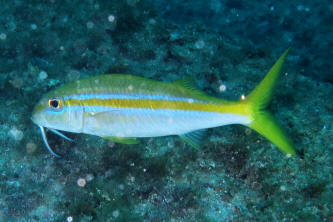
|
| Mulloidichthys flavolineatus (Lacepede
1801), the Yellowstripe Goatfish. Indo-Pacific, Red Sea over to the
Hawaiian Islands. To a maximum of seventeen inches in
length. Below: the first one a juvenile off Two-Step, Kona,
the second in Maui, and a small pair in the Cooks. |
Bigger PIX:
The images in this table are linked
to large (desktop size) copies. Click on "framed" images
to go to the larger size. |
|
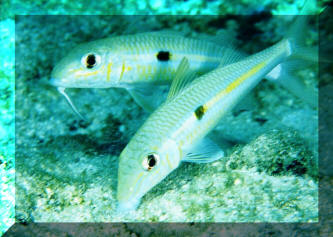
|
| Mulloidichthys martinicus
(Cuvier 1829), the Yellow Goatfish. Tropical west Atlantic. To
sixteen inches in length. One in St. Lucia, the others off the
Bahamas. An occasional import from Caribbean collectors. |
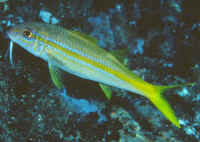
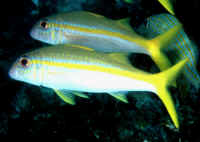
|
| Mulloidichthys vanicolensis (Valenciennes
1831), the Yellowfin Goatfish. Indo-Pacific, Red Sea to
Hawai'i. To fifteen inches in length. The first one in the
upper Gulf of Aqaba in the Red Sea, a second in the Cooks, and a
third showing their "pink" color in
Hawai'i, where it is known as the weke'ula (red); which the species
turns when stressed, dead. |
| Verticals (Full/Cover
Page Sizes Available) |
%20MD.JPG) |
Genus Parupeneus:
| Parupeneus barberinoides (Bleeker 1852), the
Bicolor Goatfish. Western Pacific. To one foot in length. A
handsome species of considerable use in the aquarium interest. Here
is one in a commercial aquarium set-up, and one "on the
reef" in Fiji. |
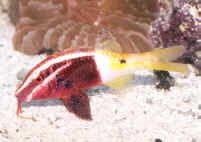 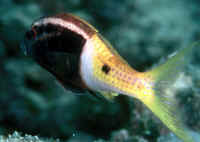
|
Bigger PIX:
The images in this table are linked
to large (desktop size) copies. Click on "framed" images
to go to the larger size. |
|
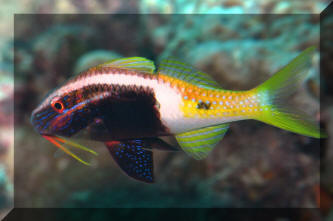
|
Bigger PIX:
The images in this table are linked
to large (desktop size) copies. Click on "framed" images
to go to the larger size. |
|
%20MD.JPG)
%20MD.JPG)
|
| Parupeneus bifasciatus (Lacepede 1801), the
Double-Bar Goatfish. Indo-Pacific, including Hawai'i. To
fourteen inches in length. Pulau Redang, Malaysia, N. Sulawesi, and
Hawai'i photos. |
Bigger PIX:
The images in this table are
linked to large (desktop size) copies. Click on "framed"
images to go to the larger size. |
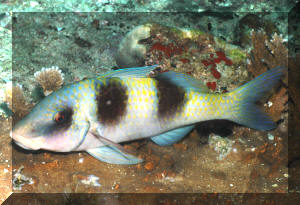
%20MD.JPG) |
| Parupeneus ciliatus (Lacepede 1802), the
Whitesaddle Goatfish. Indo-Pacific, to the Tuamotus, but not
Hawai'i or the Red Sea. To fifteen inches in length. An
occasional import into the pet-fish trade. Image taken in
Fiji. |
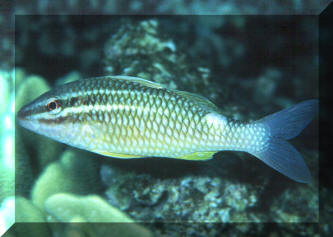
|

